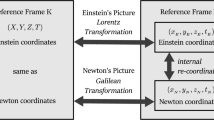Summary
The classical equations of particle motion and of classical electrodynamics are known to be covariant with respect to conformai co-ordinate transformations. This paper deals with a simple conformai co-ordinate transformation from an inertial frame to one which accelerates uniformly; it examines the physical consequences predicted by the covariant theory and the transformation. Expressions are derived for various effects of the conformai invariance on mass, length, and time measurements; the predictions of the theory are shown to be the same as the corresponding predictions derived from the general theory of relativity for the transformation being studied. The predictions of the conformai theory depend on the particular co-ordinate system chosen (with an explicit dependence on the origin). The corresponding situation prevails in general relativity with the components of the metric tensor being a function of space and time. An example of the « twin paradox » is studied. Finally, after considering the behavior of four-momentum conservation under conformai transformations, the frequency shift of radiation emitted by an excited atom falling freely in a uniform field is calculated to first order in acceleration. Identical results are obtained from the conformai and general relativistic points of view. The frequency shifts are what one would expect to obtain by properly combining the Doppler shifts and the shift arising as a consequence of the equivalence of inertial mass to gravitational mass.
Riassunto
È noto che le equazioni classiche del moto delle particelle e deU’elettrodinamiea classica sono covarianti rispetto alle trasformazioni conformi di coordinate. Qui si tratta una semplice trasformazione conforme di coordinate da una terna d’assi inerziale ad una uniformemente accelerata; si esaminano le conseguenze fisiche predette dalla teoria della covarianza e dalla trasformazione. Si deducono espressioni per i vari effetti dell’invarianza conforme sulle misure di massa, lunghezza e tempo; si dimostra che le predizioni della teoria sono uguali alle predizioni corrispondenti dedotte dalla teoria generale della relatività per le trasformazioni in esame. Le predizioni della teoria conforme dipendono dal particolare sistema di coordinate che si è scelto (con una dipendenza esplicita dall’origine). La situazione corrispondente è prevalente nella relatività. generale in cui le componenti del tensore metrico sono una funzione dello spazio e del tempo. Si studia un esempio del paradosso dei gemelli. Infine, dopo aver considerato il comportamento della conservazione del quadrimomento per trasformazioni conformi, si calcola, sino al primo ordine nell’accelerazione, lo spostamento di frequenza della radiazione emessa da un atomo in caduta libera in un campo uniforme. Si ottengono risultati identici sia dal punto di vista conforme che da quello della relatività generate. Gli spostamenti di frequenza sono quelli che ci si aspetterebbe di ottenere combinando gli spostamenti di Doppler con gli spostamenti che nascono in conseguenza. dell’equivalenza della massa inerziale a quella gravitazionale.
Similar content being viewed by others
References
H. Weyl:Sitzungsber. Preuss. Akad. Wiss. (1918), p. 465;Math. Zeits.,2, 384 (1918);Ann. Phys.,59, 101 (1919);Space, Time, and Matter (New York, 1950).
A. Einstein:Sitzungsber. Preuss. Akad. Wiss. (1921), p. 261.
W. Pauli:Theory of Relativity (New York, 1958).
J. A. Schouten andJ. Haantjes:Physica,1, 869 (1934).
J. A. Schouten andJ. Haantjes:Proc. Ned. Akad. Wet.,39, 1063 (1936).
F. Rohrlich, T. Fulton andL. Witten:Bull. Am. Phys. Soc,6, 346 (1961).
F. Rohrlich:The Static Homogeneous Gravitational Field (in preparation).
For a discussion of the relationship between conformai point transformations and conformai co-ordinate transformation see the note byT. Fulton, F. Rohrlich andL. Witten: in preparation.
J. Haantjes:Proc. Ned. Akad. Wet.,43, 1288 (1940).
T. Fulton andF. Rohrlich:Ann. Phys.,9, 499 (1960);S. A. Bludman:Phys. Rev.,107, 1163 (1957).
F. Güksey:Nuovo Cimenta,3, 988 (1956);J. A. McLennan:Nuovo Cimento 5, 640 (1957);H. A. Buchdahl:Nuovo Cimento,11, 496 (1959). References to earlier work can be found in these papers.
L. Infeld andA. Schild:Phys. Rev.,70, 410 (1946).
S. N. Gupta:Science,134, 1360 (1961).
R. C. Tolman:Relativity, Thermodynamics and Cosmology (Oxford, 1934), p. 288.
Author information
Authors and Affiliations
Additional information
Supported in part by the National Science Foundation and in part by the Aeronautical Research Laboratory.
Rights and permissions
About this article
Cite this article
Fulton, T., Rohrlich, F. & Witten, L. Physical consequences of a co-ordinate transformation to a uniformly accelerating frame. Nuovo Cim 26, 652–671 (1962). https://doi.org/10.1007/BF02781794
Received:
Published:
Issue Date:
DOI: https://doi.org/10.1007/BF02781794




